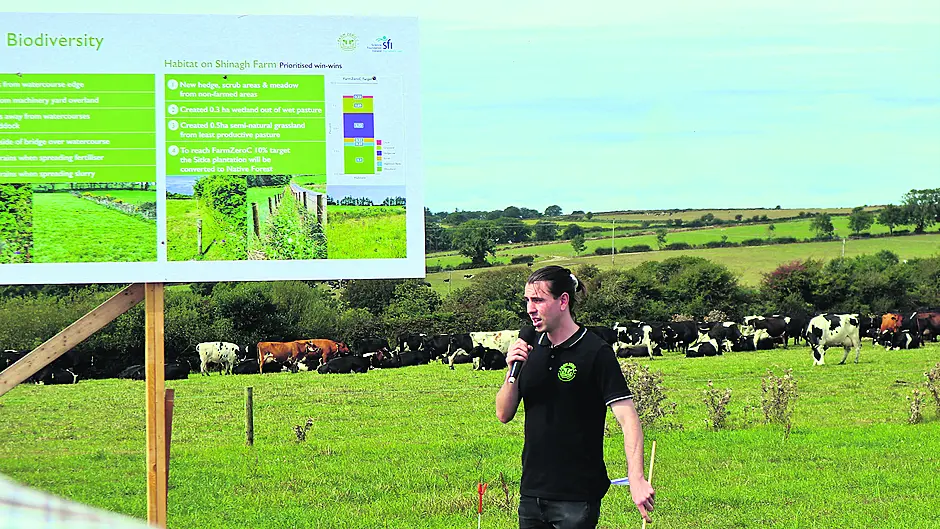Farmers at the recent open day at Shinagh dairy farm near Bandon, were told they can allow space for nature, including thistles, on their land, while still running a business that is profitable
By Tommy Moyles
IN a field on the northern bank of the Bandon river valley, ecologist Cian White swept his arm back as if to reveal West Cork.
‘You can see behind us, that is the landscape we’re trying to keep in Ireland,’ he says.
Addressing in excess of 600 people at the Farm Zero C open day on Friday last, he detailed how the 250-cow Shinagh dairy farm had increased the area under habitat since the project commenced in 2020.
Initially 7.5% of the farm was classified as ‘habitat’ and the target is to get it to 10%, in line with European policy, by the end of the decade.
The Trinity college PhD student went on to highlight how dairy farmers can make space for nature on their farms while retaining a profitable business, such as the one in Shinagh.
Beginning with the non-farmed areas, he said: ‘The strategy we’ve used is to prioritise win-wins between production and habitat. Any bit of waste or rubble around the farm, we flattened those and created habitats. By doing that we got 0.2 or 0.3 ha. After that, we looked at the least productive areas of the farm. We created a new wetland and that is from the wettest part of pasture on the farm. ‘This was a wet area of 0.3ha in a paddock that was rush-y and tractors were unable to go in there throughout the year. It was essentially a wetland already, but it wasn’t being counted, so we just pulled the fence out around it.’
The final action which pulled in another 0.5ha is some pasture that will be left as semi-natural grassland.
‘It might be cut for silage but it won’t be reseeded and will be a species-rich grassland.’
As a result of these actions alone, the farm habitat percentage has reached 8.64% of the total area of the farm and is well on course to achieve the 10% area by the end of the decade. There’s been rapid progress and you get the feeling that that target could potentially be surpassed.
The final measure that could take the farm up to 10% will be the replacing of a 0.8ha Sitka spruce plantation. The aim is to convert that over to native woodland, availing of the native woodland grant.
Whether it was by accident or design, the ecologist’s location on the last stand of the day was a good call.
With events like this there is a tendency for information overload but farmers had a bit more time to take the content of his presentation. Many of the biodiversity-enhancing measures spoken about, lined the 500-metre walk back to the farm yard from the paddock. You couldn’t miss them. Areas left for wild flowers and scrub around the milking parlour, tolerance of nettles and thistles under wires and the wet corner of a field that perennially provided challenges for tractors that had been fenced off. Those measures are extremely cheap to implement. If a farmer was to spend a bit more, a 2022 planted hedgerow consisting of nine native varieties was on display.
Owned by the four West Cork co-ops, the farm has operated as a demonstration farm since 2011.
For the first decade of its existence, the focus was on growing grass, converting that into milk solids and ultimately cash. Having firmly proved their financial sustainability, societal and climate pressures saw other pillars of sustainability increase in importance, namely environmental and social sustainability. Securing this Science Foundation Ireland-funded project, which involves a multi-agency research collaboration, including Carbery, aims to create an economically viable, carbon-neutral dairy farm and stands to benefit future dairy production in the region.








